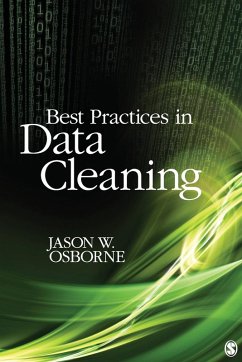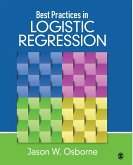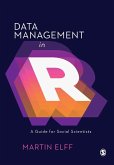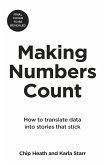Jason W. Osborne
Best Practices in Data Cleaning
A Complete Guide to Everything You Need to Do Before and After Collecting Your Data
Jason W. Osborne
Best Practices in Data Cleaning
A Complete Guide to Everything You Need to Do Before and After Collecting Your Data
- Broschiertes Buch
- Merkliste
- Auf die Merkliste
- Bewerten Bewerten
- Teilen
- Produkt teilen
- Produkterinnerung
- Produkterinnerung
Many researchers jump from data collection directly into testing hypothesis without realizing these tests can go profoundly wrong without clean data. This book provides a clear, accessible, step-by-step process of important best practices in preparing for
Andere Kunden interessierten sich auch für
![Best Practices in Quantitative Methods Best Practices in Quantitative Methods]() Jason W. OsborneBest Practices in Quantitative Methods186,99 €
Jason W. OsborneBest Practices in Quantitative Methods186,99 €![Best Practices in Logistic Regression Best Practices in Logistic Regression]() Jason W. OsborneBest Practices in Logistic Regression106,99 €
Jason W. OsborneBest Practices in Logistic Regression106,99 €![The SAGE Handbook of Digital Society The SAGE Handbook of Digital Society]() The SAGE Handbook of Digital Society125,99 €
The SAGE Handbook of Digital Society125,99 €![Data Management in R Data Management in R]() Martin ElffData Management in R34,99 €
Martin ElffData Management in R34,99 €![Spring Cleaning Spring Cleaning]() Spring Cleaning22,99 €
Spring Cleaning22,99 €![Data Science and Social Research Data Science and Social Research]() Data Science and Social Research110,99 €
Data Science and Social Research110,99 €![Making Numbers Count Making Numbers Count]() Chip HeathMaking Numbers Count11,99 €
Chip HeathMaking Numbers Count11,99 €-
-
-
Many researchers jump from data collection directly into testing hypothesis without realizing these tests can go profoundly wrong without clean data. This book provides a clear, accessible, step-by-step process of important best practices in preparing for
Hinweis: Dieser Artikel kann nur an eine deutsche Lieferadresse ausgeliefert werden.
Hinweis: Dieser Artikel kann nur an eine deutsche Lieferadresse ausgeliefert werden.
Produktdetails
- Produktdetails
- Verlag: Sage Publications, Inc
- Artikelnr. des Verlages: B88018P
- Seitenzahl: 296
- Erscheinungstermin: 10. Januar 2012
- Englisch
- Abmessung: 229mm x 152mm x 16mm
- Gewicht: 432g
- ISBN-13: 9781412988018
- ISBN-10: 1412988012
- Artikelnr.: 33677133
- Herstellerkennzeichnung
- Libri GmbH
- Europaallee 1
- 36244 Bad Hersfeld
- gpsr@libri.de
- Verlag: Sage Publications, Inc
- Artikelnr. des Verlages: B88018P
- Seitenzahl: 296
- Erscheinungstermin: 10. Januar 2012
- Englisch
- Abmessung: 229mm x 152mm x 16mm
- Gewicht: 432g
- ISBN-13: 9781412988018
- ISBN-10: 1412988012
- Artikelnr.: 33677133
- Herstellerkennzeichnung
- Libri GmbH
- Europaallee 1
- 36244 Bad Hersfeld
- gpsr@libri.de
Jason W. Osborne is a thought leader and professor in higher education. His background in educational psychology, statistics and quantitative methods, along with that gleaned from high-level positions within Academia gives a unique perspective on the real-world data factors. In 2015, he was appointed Associate Provost and Dean of the Graduate School at Clemson University in Clemson, South Carolina. As well as Associate Provost, at Clemson University, Jason was a Professor of applied statistics at the School of Mathematical Sciences, with a secondary appointment in Public Health Science. In 2019, he took on the role of Provost and Executive VP for Academic Affairs at Miami University. As Provost, Jason implemented a transformative strategic plan to reposition the institution as one prepared for new challenges with a modern, compelling curriculum, a welcoming environment, and enhanced support for student faculty positions and staff. In 2021, he was named by Stanford University as one of the top 2% researchers in the world, underlining his commitment to world-class research methods across particular domains, ultimately influencing a generation of learners. Currently, Jason teaches and publishes on data analysis "best practices" in quantitative and applied research methods. He has served as evaluator or consultant on research projects and in public education (K-12), instructional technology, health care, medicine and business. He served as founding editor of Frontiers in Quantitative Psychology and Measurement and has been on the editorial boards of several other journals (such as Practical Assessment, Research, and Evaluation). Jason W Osborne also publishes on identification with academics and on issues related to social justice and diversity. He has written seven books covering topics to communicate logistic regression and linear modeling, exploratory factor analysis, best practices and modern research methods, data cleaning, and numerous other topics.
Chapter 1. Why Data Cleaning is Important: Debunking the Myth of Robustness
Part 1. Best Practices as you Prepare for Data Collection
Chapter 2. Power and Planning for Data Collection: Debunking the Myth of
Adequate Power
Chapter 3. Being True to the Target Population: Debunking the Myth of
Representativeness
Chapter 4. Using Large Data Sets with Probability Sampling Frameworks:
Debunking the Myth of Equality
Part 2. Best Practices in Data Cleaning and Screening
Chapter 5. Screening your Data for Potential Problems: Debunking the Myth
of Perfect Data
Chapter 6. Dealing with Missing or Incomplete Data: Debunking the Myth of
Emptiness
Chapter 7. Extreme and Influential Data Points: Debunking the Myth of
Equality
Chapter 8. Improving the Normality of Variables through Box-Cox
Transformation: Debunking the Myth of Distributional Irrelevance
Chapter 9. Does Reliability Matter? Debunking the Myth of Perfect
Measurement
Part 3. Advanced Topics in Data Cleaning
Chapter 10. Random Responding, Motivated Mis-Responding, and Response Sets:
Debunking the Myth of the Motivated Participant
Chapter 11. Why Dichotomizing Continuous Variables is Rarely a Good
Practice: Debunking the Myth of Categorization
Chapter 12. The Special Challenge of Cleaning Repeated Measures Data: Lots
of Pits to Fall into
Chapter 13. Now that the Myths are Debunked... Visions of Rational
Quantitative Methodology for the 21st Century
Part 1. Best Practices as you Prepare for Data Collection
Chapter 2. Power and Planning for Data Collection: Debunking the Myth of
Adequate Power
Chapter 3. Being True to the Target Population: Debunking the Myth of
Representativeness
Chapter 4. Using Large Data Sets with Probability Sampling Frameworks:
Debunking the Myth of Equality
Part 2. Best Practices in Data Cleaning and Screening
Chapter 5. Screening your Data for Potential Problems: Debunking the Myth
of Perfect Data
Chapter 6. Dealing with Missing or Incomplete Data: Debunking the Myth of
Emptiness
Chapter 7. Extreme and Influential Data Points: Debunking the Myth of
Equality
Chapter 8. Improving the Normality of Variables through Box-Cox
Transformation: Debunking the Myth of Distributional Irrelevance
Chapter 9. Does Reliability Matter? Debunking the Myth of Perfect
Measurement
Part 3. Advanced Topics in Data Cleaning
Chapter 10. Random Responding, Motivated Mis-Responding, and Response Sets:
Debunking the Myth of the Motivated Participant
Chapter 11. Why Dichotomizing Continuous Variables is Rarely a Good
Practice: Debunking the Myth of Categorization
Chapter 12. The Special Challenge of Cleaning Repeated Measures Data: Lots
of Pits to Fall into
Chapter 13. Now that the Myths are Debunked... Visions of Rational
Quantitative Methodology for the 21st Century
Chapter 1. Why Data Cleaning is Important: Debunking the Myth of Robustness
Part 1. Best Practices as you Prepare for Data Collection
Chapter 2. Power and Planning for Data Collection: Debunking the Myth of
Adequate Power
Chapter 3. Being True to the Target Population: Debunking the Myth of
Representativeness
Chapter 4. Using Large Data Sets with Probability Sampling Frameworks:
Debunking the Myth of Equality
Part 2. Best Practices in Data Cleaning and Screening
Chapter 5. Screening your Data for Potential Problems: Debunking the Myth
of Perfect Data
Chapter 6. Dealing with Missing or Incomplete Data: Debunking the Myth of
Emptiness
Chapter 7. Extreme and Influential Data Points: Debunking the Myth of
Equality
Chapter 8. Improving the Normality of Variables through Box-Cox
Transformation: Debunking the Myth of Distributional Irrelevance
Chapter 9. Does Reliability Matter? Debunking the Myth of Perfect
Measurement
Part 3. Advanced Topics in Data Cleaning
Chapter 10. Random Responding, Motivated Mis-Responding, and Response Sets:
Debunking the Myth of the Motivated Participant
Chapter 11. Why Dichotomizing Continuous Variables is Rarely a Good
Practice: Debunking the Myth of Categorization
Chapter 12. The Special Challenge of Cleaning Repeated Measures Data: Lots
of Pits to Fall into
Chapter 13. Now that the Myths are Debunked... Visions of Rational
Quantitative Methodology for the 21st Century
Part 1. Best Practices as you Prepare for Data Collection
Chapter 2. Power and Planning for Data Collection: Debunking the Myth of
Adequate Power
Chapter 3. Being True to the Target Population: Debunking the Myth of
Representativeness
Chapter 4. Using Large Data Sets with Probability Sampling Frameworks:
Debunking the Myth of Equality
Part 2. Best Practices in Data Cleaning and Screening
Chapter 5. Screening your Data for Potential Problems: Debunking the Myth
of Perfect Data
Chapter 6. Dealing with Missing or Incomplete Data: Debunking the Myth of
Emptiness
Chapter 7. Extreme and Influential Data Points: Debunking the Myth of
Equality
Chapter 8. Improving the Normality of Variables through Box-Cox
Transformation: Debunking the Myth of Distributional Irrelevance
Chapter 9. Does Reliability Matter? Debunking the Myth of Perfect
Measurement
Part 3. Advanced Topics in Data Cleaning
Chapter 10. Random Responding, Motivated Mis-Responding, and Response Sets:
Debunking the Myth of the Motivated Participant
Chapter 11. Why Dichotomizing Continuous Variables is Rarely a Good
Practice: Debunking the Myth of Categorization
Chapter 12. The Special Challenge of Cleaning Repeated Measures Data: Lots
of Pits to Fall into
Chapter 13. Now that the Myths are Debunked... Visions of Rational
Quantitative Methodology for the 21st Century








